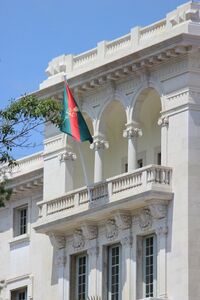Shia Convocation: Difference between revisions
No edit summary |
No edit summary |
||
| Line 4: | Line 4: | ||
|name = The Shia Convocation | |name = The Shia Convocation | ||
|native_name = Konvokasi Syi'i - De Sjiitische Vergadering | |native_name = Konvokasi Syi'i - De Sjiitische Vergadering | ||
|image = | |image = Grand_House_of_Remembrance_on_Mount_Ilias.jpg | ||
|imagewidth = 150px | |imagewidth = 150px | ||
|imagealttext = | |imagealttext = Headquarters of the Shia Convocation on Mount Ilias | ||
|caption = Headquarters of the Shia Convocation | |caption = Headquarters of the Shia Convocation on [[Mount Ilias]], Hindia Belanda | ||
|governance = Hierarchical | |governance = Hierarchical | ||
|orientation = [[Esoteric Shi'ism]] | |orientation = [[Esoteric Shi'ism]] | ||
| Line 21: | Line 20: | ||
}} | }} | ||
{{Esoteric Shi'ism Sidebar}} | {{Esoteric Shi'ism Sidebar}} | ||
The '''Shia Convocation''' ({{wp|Indonesian language|Indonesian}}: Konvokasi Syi'i; {{wp|Dutch language|Dutch: De Sjiitische Vergadering | The '''Shia Convocation''' ({{wp|Indonesian language|Indonesian}}: Konvokasi Syi'i; {{wp|Dutch language|Dutch}}: De Sjiitische Vergadering) is the supreme governing body of [[Esoteric Shi'ism]] headquartered on Mount Ilias, a verdant hill range in Java, Hindia Belanda rising over 500 metres above sea level and entirely owned by the institution. The Shia Convocation is headed by the [[Auxiliary Imam]] who acts as the spiritual guide of Esoteric Shias during the ongoing absence of the Imam of the Time (the Twelfth Imam), a period which Shias believe will continue until the {{wp|Second Coming of Jesus Christ}}. | ||
As an organisation, the Shia Convocation enjoys a unique legal status within Hindia Belanda derived from the colonial-era [[Treaty of Bukit Ilias]] which accorded the then-Shia Community of Bukit Ilias significant autonomy from colonial rule. As recorded on colonial government documents, when colonial Governors-General climbed Mount Ilias to meet the Auxiliary Imam, they were said to have paid a 'state visit', indicating that the Shia Convocation was treated in the same manner as the self-governing {{wp|Vorstenlanden}}. Following the independence of Hindia Belanda from [[Noordenstaat]], the Hindia Belandan government agreed to partially honour the treaty and recognise the Shia Convocation as a legal body with the ability to enter into treaties with sovereign countries, although neither its properties nor the land which it owns in Hindia Belanda enjoy the status of being sovereign. | As an organisation, the Shia Convocation enjoys a unique legal status within Hindia Belanda derived from the colonial-era [[Treaty of Bukit Ilias]] which accorded the then-Shia Community of Bukit Ilias significant autonomy from colonial rule. As recorded on colonial government documents, when colonial Governors-General climbed Mount Ilias to meet the Auxiliary Imam, they were said to have paid a 'state visit', indicating that the Shia Convocation was treated in the same manner as the self-governing {{wp|Vorstenlanden}}. Following the independence of Hindia Belanda from [[Noordenstaat]], the Hindia Belandan government agreed to partially honour the treaty and recognise the Shia Convocation as a legal body with the ability to enter into treaties with sovereign countries, although neither its properties nor the land which it owns in Hindia Belanda enjoy the status of being sovereign. | ||
Since the 12th century, the Shia Convocation has provided Esoteric Shias with guidance and direction through a series of documents, known as Farmans. It is empowered to | |||
== History == | == History == | ||
Esoteric Shia Islam arrived in Hindia Belanda by way of [[Maqtajer]], with the arrival of partisans loyal to the cause of the Twelve Imams. A split between the Esoteric faction, which forms the majority of the Shia population in Hindia Belanda, and the Legalist faction, which now forms the majority of the Maqtajeri Shias, occurred 300 years following the Major Occultation of the Twelfth Imam, resulting in the [[1068 Shia Schism]]. The [[Batoe Lempar Inscription]] recounts the arrival of these Esoteric Shias who fled Maqtajer and found refuge in the neighbouring Duchy of Srambi, present-day Hindia Belandan province of Malaya. There, they were met with open arms by the animist ruler [[Adipati Sangtrinila]] whose great-grandson [[Adipati Sangadinila]] converted to Esoteric Shiism circa 1269 CE and started a Shia dynasty in his name. | |||
== Governance and hierarchy == | == Governance and hierarchy == | ||
As an organised religion, Esoteric Shi'ism has a hierarchy of clergy consisting of Interpreters, Panghoeloes (a Dutch-Indonesian word originally denoting a person with religious training who served the colonial government before 1929) and Mualims, all of whom are subordinate to the Auxiliary Imam. An Interpreter is qualified to make new interpretations based on the sacred Esoteric Shia texts and be elected as Auxiliary Imam. A Panghoeloe heads a [[Bayt al-Adhkar|Provincial House of Remembrance]] and has a jurisdiction over an area known as a Kepanghoeloean. Mualims are ministers who head a Local Jurisdiction. | |||
=== The Auxiliary Imam === | === The Auxiliary Imam === | ||
[[File:Seat of the Auxiliary Imam.jpg|thumb|left|200px|Official residence of the Auxiliary Imam on Mount Ilias, Hindia Belanda]]The Shia Convocation is headed by the Auxiliary Imam, who is elected by an electoral body consisting of representatives of each local Esoteric Shia jurisdiction, numbering 2,812 in total. Once elected, the Auxiliary Imam serves for life and takes upon the role of administrative head of the Shia Convocation and, by extension, spiritual guide of the Esoteric Shia faithful. The position of the Auxiliary Imam does not replace the Imamate, which is a divinely-appointed position occupied by the hidden Twelfth Imam. | |||
=== Territorial jurisdictions === | === Territorial jurisdictions === | ||
The Shia Convocation is divided into National Councils (currently, there are two, in Hindia Belanda and Maqtajer) and Local Jurisdictions. National Councils are subordinate to the Auxiliary Imam. | The Shia Convocation is divided into National Councils (currently, there are two, in Hindia Belanda and Maqtajer) and Local Jurisdictions. National Councils are subordinate to the Auxiliary Imam. | ||
==== National Councils ==== | |||
==== Local Jurisdictions ==== | |||
=== Clergy === | === Clergy === | ||
| Line 41: | Line 47: | ||
== Responsibilities == | == Responsibilities == | ||
The Shia Convocation is responsible for providing guidance to the Esoteric Shia faithful, distributing alms, maintaining [[House of Remembrance|Houses of Remembrance]] (the principal place of worship for Esoteric Shias) and organising religious rituals. | The Shia Convocation is responsible for providing guidance to the Esoteric Shia faithful, distributing alms, maintaining [[House of Remembrance|Houses of Remembrance]] (the principal place of worship for Esoteric Shias) and organising religious rituals. | ||
=== Farmans === | |||
=== Maintenance of places of worship === | |||
Esoteric Shia religious activities, apart from the thrice-daily canonical prayers which can be performed anywhere that is ritually pure, primarily take place at [[Bayt al-Adhkar]] or Houses of Remembrance, the largest of which is the [[Capital Territory House of Remembrance]]. The Shia Convocation is responsible for the upkeep of these Houses of Remembrance, which number 780 in Hindia Belanda, as well as the oversight of their day-to-day administrations. | |||
[[Category:Hindia Belanda]] [[Category:Astyria]] | [[Category:Hindia Belanda]] [[Category:Astyria]] | ||
Revision as of 19:41, 23 January 2020
 The Shia Convocation | |
|---|---|
| Konvokasi Syi'i - De Sjiitische Vergadering | |
 Headquarters of the Shia Convocation on Mount Ilias, Hindia Belanda | |
| Orientation | Esoteric Shi'ism |
| Governance | Hierarchical |
| Auxiliary Imam | Hussein al-Hakim Billah |
| Associations | Commonwealth Conference of Religious Communities |
| Region | Hindia Belanda, Maqtajer |
| Language | English, Dutch, Indonesian and Zalqintili |
| Founder | Traditionally, the First Shia Imam |
| Congregations | 2 National Councils (Hindia Belanda and Maqtajer), 2,812 Local Jurisdictions |
| Members | 43 million Hindia Belandans, 578.000 Maqtajeris (2019 estimate) |
| Part of a series on | |||||
| Esoteric Shi'ism | |||||
|---|---|---|---|---|---|
 | |||||
| The Seven Figures | |||||
|
|||||
| The Seven Principles | |||||
|
|||||
| Beliefs and practices | |||||
| Place of worship | |||||
|
|||||
| Holy days | |||||
|
|||||
| Texts | |||||
| Governance | |||||
The Shia Convocation (Indonesian: Konvokasi Syi'i; Dutch: De Sjiitische Vergadering) is the supreme governing body of Esoteric Shi'ism headquartered on Mount Ilias, a verdant hill range in Java, Hindia Belanda rising over 500 metres above sea level and entirely owned by the institution. The Shia Convocation is headed by the Auxiliary Imam who acts as the spiritual guide of Esoteric Shias during the ongoing absence of the Imam of the Time (the Twelfth Imam), a period which Shias believe will continue until the Second Coming of Jesus Christ.
As an organisation, the Shia Convocation enjoys a unique legal status within Hindia Belanda derived from the colonial-era Treaty of Bukit Ilias which accorded the then-Shia Community of Bukit Ilias significant autonomy from colonial rule. As recorded on colonial government documents, when colonial Governors-General climbed Mount Ilias to meet the Auxiliary Imam, they were said to have paid a 'state visit', indicating that the Shia Convocation was treated in the same manner as the self-governing Vorstenlanden. Following the independence of Hindia Belanda from Noordenstaat, the Hindia Belandan government agreed to partially honour the treaty and recognise the Shia Convocation as a legal body with the ability to enter into treaties with sovereign countries, although neither its properties nor the land which it owns in Hindia Belanda enjoy the status of being sovereign.
Since the 12th century, the Shia Convocation has provided Esoteric Shias with guidance and direction through a series of documents, known as Farmans. It is empowered to
History
Esoteric Shia Islam arrived in Hindia Belanda by way of Maqtajer, with the arrival of partisans loyal to the cause of the Twelve Imams. A split between the Esoteric faction, which forms the majority of the Shia population in Hindia Belanda, and the Legalist faction, which now forms the majority of the Maqtajeri Shias, occurred 300 years following the Major Occultation of the Twelfth Imam, resulting in the 1068 Shia Schism. The Batoe Lempar Inscription recounts the arrival of these Esoteric Shias who fled Maqtajer and found refuge in the neighbouring Duchy of Srambi, present-day Hindia Belandan province of Malaya. There, they were met with open arms by the animist ruler Adipati Sangtrinila whose great-grandson Adipati Sangadinila converted to Esoteric Shiism circa 1269 CE and started a Shia dynasty in his name.
Governance and hierarchy
As an organised religion, Esoteric Shi'ism has a hierarchy of clergy consisting of Interpreters, Panghoeloes (a Dutch-Indonesian word originally denoting a person with religious training who served the colonial government before 1929) and Mualims, all of whom are subordinate to the Auxiliary Imam. An Interpreter is qualified to make new interpretations based on the sacred Esoteric Shia texts and be elected as Auxiliary Imam. A Panghoeloe heads a Provincial House of Remembrance and has a jurisdiction over an area known as a Kepanghoeloean. Mualims are ministers who head a Local Jurisdiction.
The Auxiliary Imam
The Shia Convocation is headed by the Auxiliary Imam, who is elected by an electoral body consisting of representatives of each local Esoteric Shia jurisdiction, numbering 2,812 in total. Once elected, the Auxiliary Imam serves for life and takes upon the role of administrative head of the Shia Convocation and, by extension, spiritual guide of the Esoteric Shia faithful. The position of the Auxiliary Imam does not replace the Imamate, which is a divinely-appointed position occupied by the hidden Twelfth Imam.
Territorial jurisdictions
The Shia Convocation is divided into National Councils (currently, there are two, in Hindia Belanda and Maqtajer) and Local Jurisdictions. National Councils are subordinate to the Auxiliary Imam.
National Councils
Local Jurisdictions
Clergy
The Esoteric Shia clergy consists of Interpreters, Panghoeloes (a Dutch-Indonesian word originally denoting a person with religious training who served the colonial government before 1929) and Mualims. Interpreters are the highest religious position an Esoteric Shia can achieve.
Responsibilities
The Shia Convocation is responsible for providing guidance to the Esoteric Shia faithful, distributing alms, maintaining Houses of Remembrance (the principal place of worship for Esoteric Shias) and organising religious rituals.
Farmans
Maintenance of places of worship
Esoteric Shia religious activities, apart from the thrice-daily canonical prayers which can be performed anywhere that is ritually pure, primarily take place at Bayt al-Adhkar or Houses of Remembrance, the largest of which is the Capital Territory House of Remembrance. The Shia Convocation is responsible for the upkeep of these Houses of Remembrance, which number 780 in Hindia Belanda, as well as the oversight of their day-to-day administrations.
